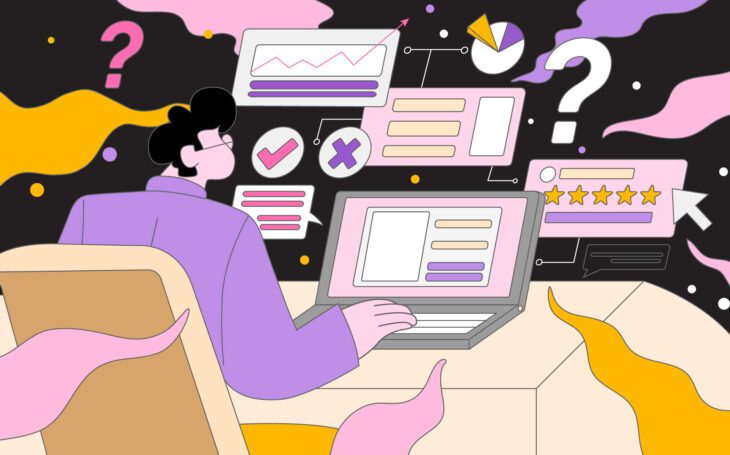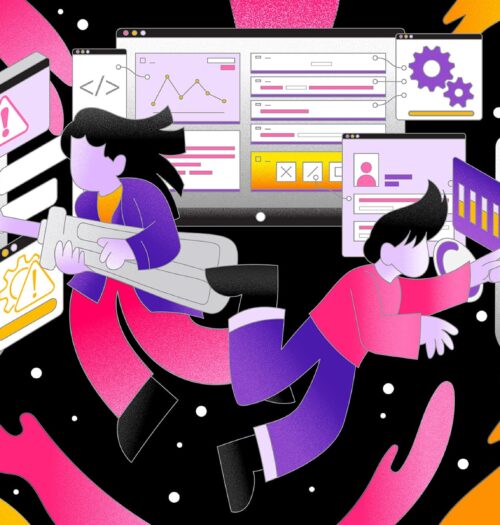🎁 Free 30-day publishing fees on Pay-As-You-GO. Get 15% off when recruiting from the UserQ Panel, with code HELLO15
Product development, User experience
Tips to write effective prototype testing questions

Success in prototype testing can take many forms. For some, successful testing is when they receive authentic and actionable feedback, while for others, it’s how much the users enjoyed the product.
However, preceding effective prototype testing are the questions that will get all the right answers. The right questions will ensure you can unlock the full potential of the testing process and use them to build a customer-centric product.
In this guide, we’ll go through the thought process to create the right prototype testing questions and share the importance of asking the right questions.
Why is asking the right prototype testing questions important?
Prototype testing is a tangible way to know what your users think about your product. Whether it’s the design, a feature, performance, security, or anything else, the testing offers a unique opportunity to build a product that your target audience wants to engage with.
The way your users can pinpoint the exact areas of frustration is akin to a treasure trove. This is because you will directly know the secret to creating a user centric solution. But once again, all of this depends on the right input, which means asking the right questions.
Do different prototypes require different types of questions?
Different types of prototypes are used at different stages of product development. Consequently, the types of questions you ask must align with the stage of the design prototype.
| Prototype type | Description | Testing type | Types of questions |
| Paper prototypes | These are basic sketches on plain paper that are either printed or hand-drawn and represent the core idea of the product. | It includes concept testing, focused on getting the “idea approval” from your final users | Ask questions to better understand what motivates your users. Use this understanding to validate ideas and explore user behaviour related to a specific topic. You can ask them if they “would use” a product related to your product idea. |
| Wireframe prototypes | A black and white representation of the digital touchpoint that you ought to build added small details on where to place images, content, etc. | In this stage, conduct flow testing, to evaluate the overall user journeys and gain feedback on the navigation flow (checking its intuitiveness and smoothness) and complexity of tasks. | Questions will revolve around the navigation structure, information architecture, and page layout asked with an aim to gauge initial feedback on the design’s validity and efficiency of the flow before showing the visual concept. |
| Low-Fidelity prototypes | Basic UI representation with rudimentary interactions that isn’t too much focused on the visual elements and fluid interactions of the product without focusing too much on design nuances. | Usability testing, focused on testing the wip interface, flows and UI of the product. | Set questions to gain feedback on the functionalities, flows, and interface and user flow and uncover usability issues related to core design flows. |
| High Fidelity prototypes | These are highly detailed prototypes with intricate design elements and interactions resembling the final product. Such prototypes can either be a Figma prototype or are built in frontend solutions like HTML and CSS. These designs are clickable and have real interactions similar to fully developed apps, but isn’t connected to the backend. | Usability testing focused on every final detail of the interface and flows, including labelling, imagery and copy. | Questions will revolve around assessing the product’s usability to assess interactions and overall user experience. You can also add questions about the product’s aesthetics and visual appeal. |
Types of prototype testing questions you must ask
Depending on the use case, target audience, and your testing goals, the types of prototype testing questions will change. So, considering your requirements, you can choose from the following types of questions.
1. Close-ended questions
These questions ask respondents to choose from predefined responses like you do in a multiple-choice question. Moreover, they can also be “Yes” or “No” questions, and the answers are tabulated to create quantitative data.
- On a scale of 1-5, with 1 being “strongly disagree” and 5 being “strongly agree,” how easy was it to navigate the website?
How would you rate the overall user experience? Rate between Excellent to Poor.
2. Open-ended questions
These questions give your participants the option to give descriptive answers. Here, you won’t have to give options or any predefined choices. The questions will include things like “How” or “Why” and will bring qualitative data.
- What was your overall impression of the product/service?
- What did you like most about the product/service?
- What challenges did you encounter while using the product/service?
- How did you feel about the [design element] of the product/service?
- Can you share a story about your experience using this product/service?
3. Scenario-based tasks
Scenarios ask respondents to imagine themselves in hypothetical situations and ask them to share their answers. The situations are related to the product or service analysing how it behaves when exposed to different tasks and what changes need to be made to achieve a goal.
- Imagine yourself as a project manager of a development team on a tight deadline; how do you plan to use our product to deliver the project on time? As a project manager, you will need to create a Gantt using this tool to list all the activities we inserted before. How would you proceed from here?
- Imagine you want to make a purchase on our app. You now need to finalise the purchase of the selected items, how would you proceed to checkout from here?
- You are a frequent user of our product and have recently encountered a problem that’s preventing you from fulfilling a specific task. How will you share the report with our support team and what sort of information can you easily share to help them resolve the issue?
4. Product strategy questions
A common part of product development exercise, product strategy inquiries revolve around the fact that what problem is your product solving, who is the ideal user, and what are their pain points. They help decide which features and functionalities are essential before the next release or product launch.
- In the future, what new features or functionalities would you like to see added to our platform?
- What are three problems for which you want to see a new feature or solution?
- What changes would you like to see in our product to make it more intuitive and easy to use?
Knowing the types of questions you can put in front of the target users is an essential part of the entire exercise. The questions you put forward will need a discussion guide, which must include the design issues, features, and functionality aspects for which you need user insights. With this in mind, let’s move on to the next section where we talk about all the other important tips to write effective prototype testing questions.
Best practices and tips to write effective questions for prototype testing
Prototype testing is an important part of the product development process. Combining prototype testing with user testing can help you build an iterative product design and ensure the products you build meets the target expectations. Hence, you cannot do anything in haste and must plan everything ahead to achieve great results. Here are a few tips that will set you up for success.
1. Align the questions with your testing goals and objectives
The questions you ask from the respondents must directly address the key objectives of the prototype test. If you need accurate answers, ask the right questions; it’s as simple as that.
Doing so means understanding your user’s pain points, desires, and motivations before setting the questions. Plus, decide the metrics you’ll use to measure the effectiveness of the prototype tests and acquire user feedback.
2. Recruit users for testing purposes carefully
The type of users you select for testing can alter the answers. For instance, hiring accustomed users to check how a new feature will look and appeal to them against hiring people with a generalised interest in your product will be different.
So before you hire testers, think about their contribution to your product development, how well they can answer design-specific questions, and consider other technical details.
3. Avoid leading questions
Leading questions are the ones that steer the users in a particular direction. These questions limit the person’s feedback to a certain area or feature.
For instance, “What did you like the most in our application’s search feature?” Here, you are already setting the precedent for the user with the preconception that the search feature is indeed likeable.
So, even if the user has had a bad experience with the feature, they will hesitate to share because you are asking them about what they liked.
Instead of this question, ask, “What was your first impression of the product?” Or How would you describe the search feature?”
4. Separate the questions based on the testing stage.
Screening questions where you screen participants and align their participation goals with your testing goals are different from post-study or during-the-research questions. So, ensure you are asking questions according to the testing stage.
For instance, “Have you previously had any experience with a similar product or service in the past few months?” is a screening question. And “Overall, how did you find your initial experience with the product?” is a post-study question.
So, always set the right question for the right stage to acquire the right answers.
Above all, prototype testing is one of the ways to build trust and encourage your users to participate in the product development process.
Conclusion
Prototype testing is a crucial exercise in the product development process. While asking the right questions is important, you’ll also need a robust platform to analyse the results. This is where Userq comes in with its feature-rich prototype testing platform you can use for validating product designs, ascertaining their usability, and gathering analytics to improve product development outcomes.
Check Userq’s testing tools which you can use along with selecting localised respondents from a user panel that will answer questions in Arabic and English.
Related Post

The benefits of user research
User research is typically a key part of product development and business growth all around the world, but here at

Maximizing product managers’ ROI with
The importance of ROI for product managers Understanding remote user testing Remote user testing allows you to evaluate your product,

10 Warning signs of a
User experience (UX) design is critical in shaping the end-user’s interaction with digital solutions. As it plays a vital role
Subscribe to our
product newsletter!
Receive emails about UserQ updates, new features,
offers and latest trends.


